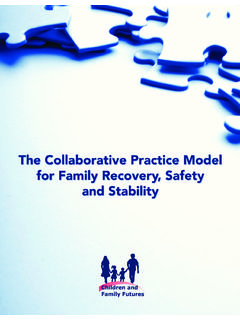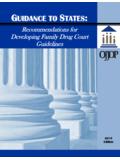Transcription of SEI - The Framework: Five Points of
1 National Center on Substance Abuse and Child Welfare: A Program of the Substance Exposed Infants Substance Abuse and Mental Health Services Administration Center for Substance Abuse Treatment National Conference 2011. and the Administration on Children, Youth and Families Child ' B. Children's Bureau Office on Child Abuse and Neglect 4940 Irvine Blvd., Suite 202. Irvine, CA 92620. 714-505-3525. 2. SEI - The Framework: Five Points of Intervention Pre-pregnancy and public awareness P. Prenatal t l screening i and d supportt To Obtain a Copy: Screening at birth / Services to infants 0-3 and beyond Services to parents So the birth event is one of several opportunities to make a difference, not the only one!
2 1. Policy and Practice Framework: Five Points of Intervention The Policy Context 1. Pre-pregnancy awareness of substance use effects Child Abuse Prevention and Treatment Act (CAPTA). amendments of 2003 and 2010. 2. Prenatal screening Initiate enhanced Referrals of newborns identified as exposed illicit and assessment prenatal services substances; alcohol and FASD added in 2010. Referrals of children birth to age 3 to Early 3. Identification Intervention Services Child at Birth Parent Affordable Care Act expansion of treatment and 4. Ensure infant's safety and System Respond to parents'. preventive services; 2008 parity legislation affecting respond d to t infant's i f t' needs d Linkages Li k needs d coverage Research on fetal alcohol spectrum disorders and 5.
3 Identify and respond alcohol-related neurodevelopmental disorders to the needs of System Identify and respond Proposed State legislation aimed at both fetal alcohol Infant Preschooler Linkages to parents' needs Child Adolescent exposure and maternal abuse of illegal drugs 6. The Reality: Use During Pregnancy National vs. Local Rates of SAMHSA, Office of Applied Studies, National Survey on Drug Use and Health, 2008-2009 Annual Average Positive Screens Total Births 2009: 4,131,000. Substance Used (Past 1st Trimester 2nd Trimester 3rd Trimester 50%. M th). Month) 45%. National Prevalence National Prevalence National Prevalence 40%. CA. 35%. Any Illicit Drug 30% LA.
4 25% NJ. Alcohol Use 20% IL. 15% HI. Binge Alcohol Use 10%. NV. Cigarettes 5%. 0% So Oregon SAMHSA, Office of Applied Studies, National Survey on Drug Use and Health, 2007-2008. Accessed 07/22/11 from . Alcohol Tobacco Illicit National Vita Statistics Reports, Volum 59, Number 1, December 8, 2010. Accessed 07/22/11 from Estimates based on 2008 data. Drugs (C) NTI Upstream, 2010. 2. Despite These High Rates Percent of Women Pregnant at Time of Substance Abuse Treatment Admission The rates of admission of pregnant women to treatment are very low 12. Overall, of women were The national average is that only of all 10. pregnant at treatment admission women admitted to treatment are pregnant and 8.
5 Less than 2% of all admissions (US total in 2009 was 24,759 pregnant women /estimated total of 410,000 women needing 6. brief or longer treatment ). 4. Priority Priority access to treatment treatment is not policy at the present time 2. Brief interventions in response to prenatal 0. Wisconsin Alaska Arkansas Iowa Idaho Kansas Maine New Mexico Connecticut Hawaii Michigan New Jersey New York Oregon Rhode Island Utah Vermont Puerto Rico Mississippi Missouri Alabama Arizona Delaware Georgia California Florida Indiana North Dakota Oklahoma South Dakota Tennessee Colorado Illinois Louisiana Massachusetts Minnesota Montana Nebraska Nevada Ohio Texas Kentucky Maryland Washington Wyoming District of Columbia New Hampshire North Carolina Pennsylvania South Carolina Virginia West Virginia screening are Medicaid-reimbursable, but few states are fully using the available tools 9.
6 Source: AFCARS data, 2009. Why are substance-exposed We can't afford not to take on this births important? problem Estimated annual costs of FASD in one study were Though a small percentage of CWS $21,642 a year.*. cases, these children are disproportionately Another 2002 estimate found that the total lifetime costs for caring for those children that survive prenatal affected by many lifetime conditions exposure to drugs or alcohol ranges from $750,000 to Prenatal exposure to alcohol is the leading $ million.**. cause of mental retardation If costs for special education and mental retardation (which is the most preventable effect of prenatal alcohol Special education classrooms contain a exposure) are added, these estimates rise even higher.
7 Disproportionate number of children who were None of these studies account for failed foster care placements or adoptions which some estimates place prenatally exposed to ,4 as high as 25% for special needs children, including those prenatally exposed to drugs or alcohol.**. SEIs require a higher level of public spending than many other target groups *The burden of prenatal exposure to alcohol: revised measurement of cost, (2009) Stade, et al. Costs in Canadian dollars **Estimated Costs Related to the Birth of a Drug and/or Alcohol Exposed Baby, (2002) Kalotra , 11 ** 3. No One Agency The Needed Partners Collaboration on SEI issues requires roles for.
8 The SEI issue does not belong to any one Hospitals Private physicians agency, because it demands Health care management plans comprehensive services Maternal and child health Children's and adult mental health provided along a continuum of Domestic violence agencies prevention, intervention and treatment Child welfare Drug and alcohol prevention, treatment and aftercare at different developmental p stages g in the life Developmental disabilities agencies of the child and family Schools and special education No single agency can deliver all of these Family/dependency courts Child care and development Employment and family support agencies And more.
9 13 14. State Policy, Practice and Models 10-State Study The 10-State Study Findings Models Findings, Model Implementation s and Within the Five Points of Intervention 1. Pre-pregnancy and public awareness p Implementation 2. 2. P. Prenatal t l screening i and d supportt 3. Screening at birth 4. Post-natal services to infants 5. Post-natal services to parents 15 16. 4. 1. Pre Pregnancy 1. Pre Pregnancy What States and Localities Are Doing: What Needs Doing: States have worked with institutions of higher Expanded efforts on campuses and among education in disseminating this message high risk young women and men Federal "Drug Free Schools and Communities Act Approaches to industry to fund expanded Amendments of 1989".
10 Universities and educational institutions that accept public information efforts f d l f di federal funding must notify their employees and t tif th i l d students that use of alcohol during pregnancy may have detrimental effects on their children Model: University of Massachusetts 17 18. SAMHSA, OAS, National Survey on Drug Use and Health, 2002 and 2003. 2. Prenatal Screening and Services 2. Prenatal Screening and Services What States and Localities Are Doing: What Needs Doing: All States had some prevention efforts and Medicaid guidelines for prenatal screening some form of prenatal screening efforts Implementation of SBIRT brief intervention Model: Washington State has developed detailed Admissions of pregnant women are a very guidelines for prenatal screening, and a quality improvement effort that seeks universal small percentage of total admissions to screening for substance use treatment.












